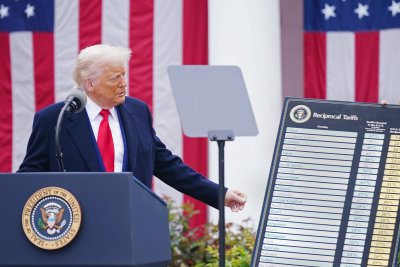July 7 (UPI) — President Donald Trump on Monday informed 13 nations, including Japan and South Korea, that new tariffs of at least 25% will be imposed starting Aug. 1 on most goods sent to the United States.
Trump sent letters to Japanese Prime Minister Ishiba Shigeru and South Korean President Lee Jae-myung informing them of a 25% duty. He shared the letters on Truth Social on Monday afternoon.
He then sent letters to five other nations’ leaders, raising tariffs 25% for Malaysia and Kazakhstan, 30% for South Africa, and 40% for Myanmar and Laos.
In another batch, he imposed 36% on Cambodia and Thailand, 35% on Serbia, 32% on Indonesia, 30% on Bosnia and 25% on Tunisia. Meanwhile, White House press secretary Karoline Leavitt said more letters will be sent.
After the announcement, American stocks tumbled and stayed in the red. The Dow Jones Industrial Average declined 422.17 points, or 0.94%, to 44,406.36, the S&P 500 slumped 49.37 points, or 0.79%, to 6,229.98, and the tech-dominant Nasdaq Composite was down 188.59 points, or 0.9%, to 20,412.52. Setting record highs Thursday were the S&P at 6,279,35 and Nasdaq at 20,624.51. DJIA that day reached 44,828.53, below the record 45,014.04 on Dec. 4.
U.S.-listed Japanese automakers dropped significantly: Toyota 4.02%, Nissan 7.16% and Honda 3.86%. Korea’s Kia was half a percent down and Hyundai was up about 2.82% with their cars mostly made in the United States. American companies also produce cars from other countries and import parts, so tariffs will be tacked onto them.
“Markets are tilting to a risk-off posture as participants brace for the chance of Trump tariff-sparked turbulence in the coming hours and days,” Jose Torres, a senior economist at Interactive Brokers, wrote in a note obtained by Business Insider.
“At 25%, it is possible, but challenging, to trade with Japan and Korea,” Barry Appleton, co-director of the Center for International Law at New York Law School, told CBS MoneyWatch. “This rate was carefully set at the higher side of the spectrum. In essence, trade with the U.S. now is a pay-to-play proposition for Japan, Korea and likely others to come.”
Besides Japan and South Korea, other nations are bracing for higher tariffs, including the 27 countries in the European Union. USA Today reported as many as 100 letters could go out to nations.
The U.S. president had imposed a Wednesday deadline for nations to negotiate better trade deals. On April 2 on “Liberation Day,” he announced 10% across-the-board baseline tariffs on 90 trading partners and harsher ones for the worst offenders. Stocks and bond prices slumped.
One week later, he pushed the deadline back until July 9 for the reciprocal duties.
Leavitt said Trump will sign an executive order to delay the deadline to Aug. 1, when the new ones will be implemented. Also, new trade deals with some nations will be signed by the deadline, she said.
The original reciprocal tariffs were 24% for Japan; 25% for South Korea and Malaysia; 48% for Laos; 45% for Mayanmar; 27% for Kazakhstan; and 31% for South Africa.
The letters state that the 25% tariffs are separate from sector-specific duties on key product categories.
“Goods transshipped to evade a higher Tariff will be subject to that higher Tariff,” Trump said. That refers to moving goods to an interim country before their final shipment to the United States.
The letters say that the higher tariffs are necessary because the other nations are taking advantage of the United States.
“Please understand this 25% number is far less than what is needed to eliminate the Trade Deficit disparity we have with your Country,” Trump wrote to countries.
“These Tariffs may be modified, upward or downward, depending on our relationship with your Country. You will never be disappointed with the United States of America.”
In 2024, the U.S. had a $68.5 billion goods deficit with Japan and a $66 billion with South Korea, according to the Office of the United States Trade Representative.
Trump also warned that the rates could be higher if they impose retaliatory duties.
“As you aware, there will be no Tariff if Korea, or companies within your Country, decide to build or manufacture product within the United States and, in fact, we will do everything possible to get approvals quickly, professionally, and routinely — in other words, in a matter of weeks,” Trump wrote to South Korea’s president.
Trump on Monday threatened nations that support BRICS nations — Brazil, Russia, India and China — would be slapped with an additional 10% tariff. India is facing a 26% reciprocal tariff with Brazil at 10%. No new tariffs have been imposed on Russia though they already are high.
Deals have been announced with Great Britain, China and Vietnam.
For Britain, there is a 10% baseline tariff on most goods but an exemption for 50% tariffs on steel and aluminum on most other countries. Instead, it is 25%. Britain was originally to be imposed only the 10% rate. U.S. tariffs on British car imports and auto parts will be reduced to 10% for 100,000 cars.
In China, there is a 30% tariff on most Chinese imports, with exceptions on smartphones and computers. Originally the tariff on most goods was to be 134%.
In Vietnam, imports are subject to a 10% tariff with products originating from third countries shipped to the United States in Vietnamese ports increased to 40%. The original reciprocal was 46%.
Trump has wanted to boost the American manufacturing sector, but economists fear this strategy will lead to product shortages and inflation.
